Upselling & Cross-Selling – Best Strategies To Boost eCommerce Revenue
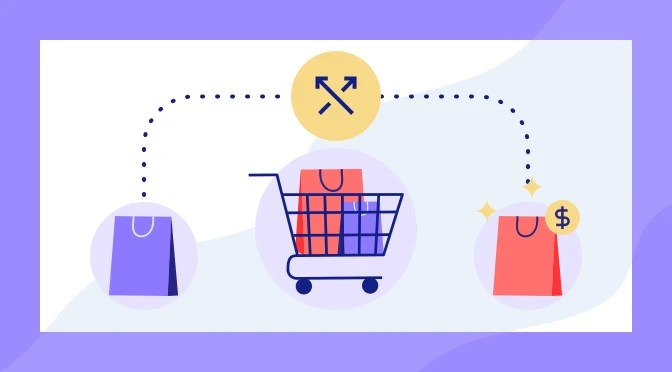
Table of Contents
Upselling and cross-selling products have no doubt been one of the most proven marketing strategies for eCommerce merchants in the last decade. However, it is also common to see people use these words interchangeably either while writing or speaking.
But what is really the difference?
What is Cross-selling?
The right cross-selling definition is the tactic of encouraging customers to purchase related or complementary items, perhaps for a lesser fee than the original price tag.
For instance, Alice visits a fashion store to buy a $100 dress but ended up buying the dress plus a fashionable shoe, because the latter was sold as a complementary product and for a lesser price.
What is Up-selling?
The right Up-selling definition is the practice of subtly encouraging a shopper to buy a higher-priced product that matches their primary item but offers more benefits.
A perfect example will be if Alice, with an original budget of $100, ends up buying a $200 dress because it was advertised to her in a manner that swayed.
In both cases, we notice that the merchant generates more revenue than was initially possible, a benefit that makes upselling and cross-selling products a hot strategy for salespersons.
If you regularly shop online, there’s a significant chance that you’ve purchased an item because it was displayed as one of the many cross-selling or upselling techniques that exist. Also, if you sell online, then there’s an even higher chance that you’ve tried to increase sales by adopting any of the strategies.
Bundling too is another slightly different method to increase eCommerce sales whereby customers are presented with similar or complementary products with the option to get the listed items at a discounted price if they buy all the items.
Having discussed so far what is upselling and what is cross selling, we will from this point consider why upselling and cross-selling products are important ways to boost eCommerce revenue.
Why are Cross-selling and Up-selling Techniques Really Important for your business?
1. Improve customer retention
Up-selling and Cross-selling is undoubtedly an excellent way to reduce the number of customers that you lose to competitors. It gives you a chance to present to customers a product or service that they may not know you have but could meet their needs.
Using the cross-selling example we mentioned earlier, we notice that Alice could have ended up buying shoes from another fashion store if she did not receive an offer that she could afford. For the upsell, she may as well have spent the extra $150 at another store, perhaps for another dress that the first merchant had in stock.
Interestingly too, upselling and cross-selling products also represent a cost-effective customer retention strategy when compared to other tactics such as loyalty rewards, discounted offers, and any offline campaign you can come up with.
In the end, you’ll save some money from your marketing budget to invest in other core areas of your eCommerce business.
2. Offer them a brilliant way out for buying products.
When you offer personalized recommended products to visitors, you’re practically saving them the hassle of having to go search for those products themselves.
Such helpful guidance, coupled with a compelling explainer video or description for the additional products means your developed eCommerce store can become the all-in-one store for your customers and adds more money to your pocket.
Putting Alice into perspective once again, there is a possibility that she visits several stores to find a matching dress and shoe, but fails to find any that matches her taste.
The merchant removes that workload in exchange for more revenue, presenting a win-win situation for everyone in the market cycle.
3. Assist them, earn trust and loyal customers
In line with the point we just discussed, up-selling and cross-selling products are an excellent way to assist customers, earn their trust, and eventually turn them into loyal and regular shoppers.
Given that Alice has gotten what she needs and received a little help in doing that, she is likely to trust the merchant more and perhaps even refer her friends.
4. Revenue Generation
As you can already tell from the points discussed so far, mastering the art of up-selling and cross-selling products means optimum revenue generation for an eCommerce merchant.
However, the secret to achieving the best result with upselling and cross-selling is to avoid overusing the technique, but instead, apply it when necessary.
The reason is that customers can quickly tell when products that are added to their bundle is beneficial when compared to their primary purchase, and will ditch a store where they receive too many suggestions.
If done right, however, no money is left on the table, and full customer satisfaction would be reached.
What Cross-selling and Up-selling Techniques are Beneficial for eCommerce businesses?
1. Embrace the right methods that get results
Before you jump into upselling and cross selling products, it is vital to understand the processes that are already bringing in results for the top eCommerce sites in your niche. You can get this information by extensively researching these competitors and the offers that are available on their checkout page.

Consider, cross selling example from Amazon pointed out by Neil Patel when you try to purchase the Canon Powershot ELPH. Amazon recommends under their frequently bought section, a compact camera case, and a flash memory card (all items that are beneficial to the prospective customer).
To ensure that the information you gathered from competitors is workable, you can organize a quick survey for your trusted customers to find out what they think about receiving personalized recommended offers to complement their primary purchase.
Armed with that information, you can finalize and define workable cross-selling and upselling techniques for your eCommerce website in line with industry standards. That way, the chances of failure are reduced, and the possibilities of success greatly improved.
2. Demonstrate the Time and Scarcity of Product Rewards
This step is crucial since it obeys the common law that ‘customers are more likely to complete a purchase if there’s a level of emergency attached to the offer.’
Putting this into perspective, your cross-sell and up-sell products widget could include a limited time offer for the displayed recommend items and show them what they will lose if they missed the chance to add the product to their shopping cart.
A countdown timer attached to a simple banner image of the product can do the trick.
3. Visualize User-centric Content
To get customers to trust the bundled products with less hesitation, it is vital to add recommendations and testimonials, in the same manner, you use these features on your product description pages and videos.
Also, instead of merely using the ‘frequently bought together’ tag, as shown in the Amazon example earlier, you could use a more subtle sales pitch such as “the last X number of customers who ordered product Y also got these.”
By adopting this strategy, you make the buying decision easier for customers as they believe that someone else must have grabbed the perceived value that you’re helping them to see.
4. Relevant offering recommendations/context
A rare mistake we see eCommerce merchants make when up-selling or cross-selling products are recommending bundle products that do not match the primary purchase or are out of context with the customers’ selection.
To sell effectively, brilliantly use personalized messages and products which can trigger buyer emotions, not just the items you think they need.
How Does Cross-selling and Upselling Techniques Ace Out?
In this section, we will go over some of the best ways to implement cross-selling and up-selling on your eCommerce website.
1. Up-sell stands out with brilliant narrowing options
To be successful in selling higher-priced products, you could use the “Featured Products” section of your product categories, since it is one of the most visited pages on an online store. Other options that we will deliberate under this heading include seasonal offers and the similar product widget.
— Featured Products
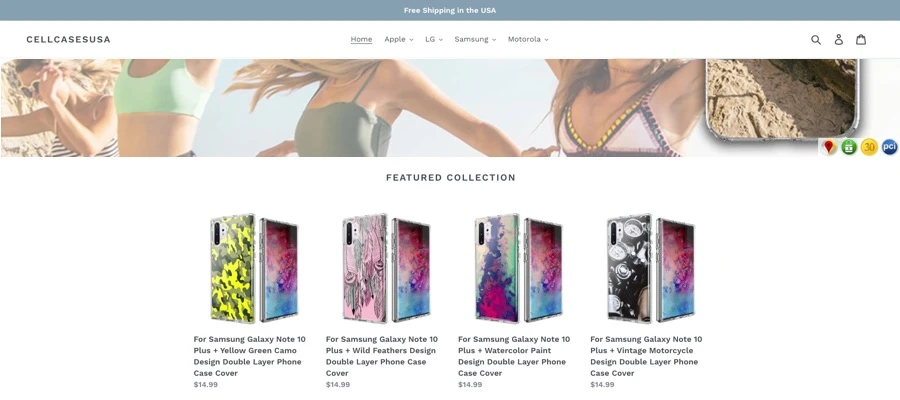
Customers who do not have a shopping list often visit the featured products section of a website to find inspiration on what items they need to purchase. You can use this impulse-induced buying decision to your advantage as an eCommerce merchant by display the majority of your upsell products on this section of your website.
Among other upselling examples, we picked this simple one from CellCasesUSA. You’ll notice the expensive Galaxy Note 7 banner on the top page with other products like the Galaxy S6 Edge and Apple iPhone and iPod phone cases. Apparently, these are the most expensive products in their gallery and are thus displayed first to potential customers.
Of course, this does not mean that you should not display low-priced products as we see CellCasesUSA eventually displaying personalized phone cases at another section of their homepage.
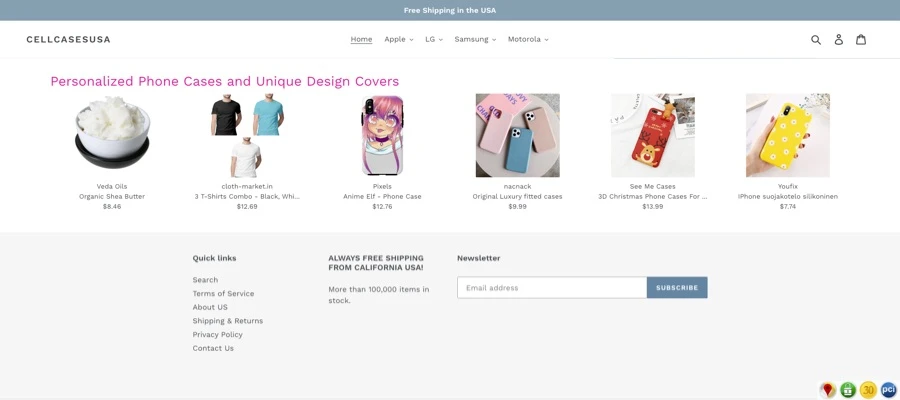
Find a balance between offering your most expensive products and the low-priced ones, and then you can up-sell products effectively.
— Seasonal Offers
Another excellent way to up-sell products is to take advantage of seasons in your industry.
Consider this example from Kay Jewelry, upselling products in the buildup to the engagement season. The 20% off all bridal jewelry offer and the limited time for the offering make it an enticing prospect for people who are planning a wedding.
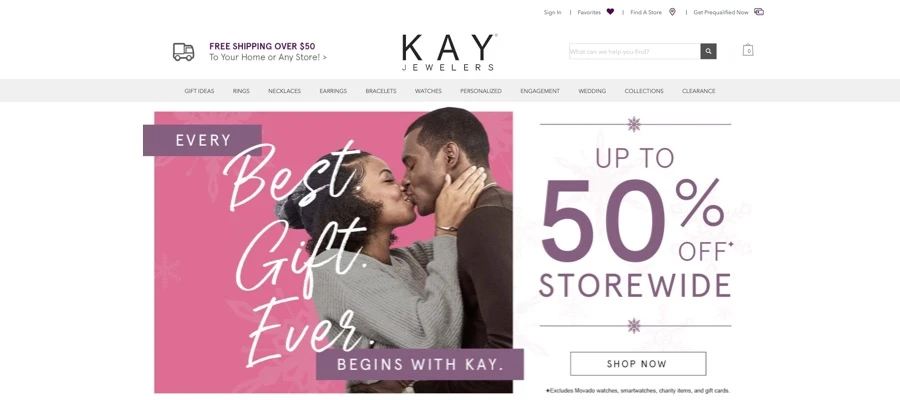
Also, the fact that the offer is displayed on the homepage means it is likely to get higher conversions than when it is placed on any other sections of their online store.
In conclusion, specific seasons offer an excellent opportunity for upselling and cross-selling products, and taking advantage of the opportunity can unlock a new revenue channel for you as an online store owner.
– Similar Products
The ‘similar products’ strategy is one of the most common ways to cross-sell and up-sell products effectively since it relies on the belief that a customer who is interested in Product A may as well be attracted to Product B, C, D, and a few more others.
Our featured example shows a website selling the “blackpepper perfume” while cross-selling products following the personalized message, “If you love Blackpepper Eau de Parfum,” we recommend you try.”
The customer, in this case, also sees a list displaying the different sizes of the primary product that the merchant has in stock, making it difficult for the customer to only stick with their initial buying decision. This strategy is compelling and likely increases up-sell and cross-sells conversion rates for their business.
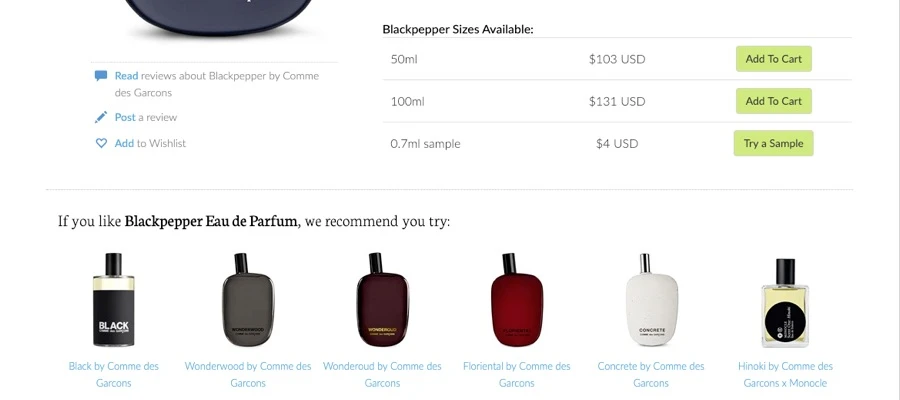
2. Offering Bundle Solutions
Bundling solutions take us back to our earlier example of how eCommerce giant, Amazon, has mastered the art of up-selling their products to increase revenue.

A customer who takes the bait on this offer ends up spending $117 on three items, even though their initial purchase was the Canon Camera, which sells for less than $100.
The best part of it is that the shopper is not made to feel that the up-sell offer is imposed on them since there’s a visible option to proceed to checkout with only the Canon Camera.
There is also the ‘add to the wishlist’ option, which potentially helps Amazon’s retargeting efforts to any customer who fails to buy the up-sell products at the first promotion. You could also go one step further to include the wish list items to get more off your email marketing campaigns.
3. Smart Recommendation through Mini cart
You can practice upselling or cross-selling products using the mini cart widget which pops up when a user is about to check out. The idea behind this is to promote an item now that the shopper is ready to part with their money.
Psychologically, the customer is already in a spending mode and more open to reviewing better or complementary options.

The example above from an online cosmetics store provides the perfect idea of how you can set up a format for smart recommendations in a mini cart.
The customer sees a message that they could get ‘free shipping’ by ordering an extra $23 worth of items, which the cross-sell products on the right side of the screen give the customer options on how to meet the threshold for free shipping.
Also, note that nothing is lost as the customer chooses the checkout with the only product they have in the cart, even though the odds are against the chances of that happening.
4. Exciting Package Deals
Listing exciting package deals represent one of the strategies that allow you to cross-sell and up-sell products at the same time.
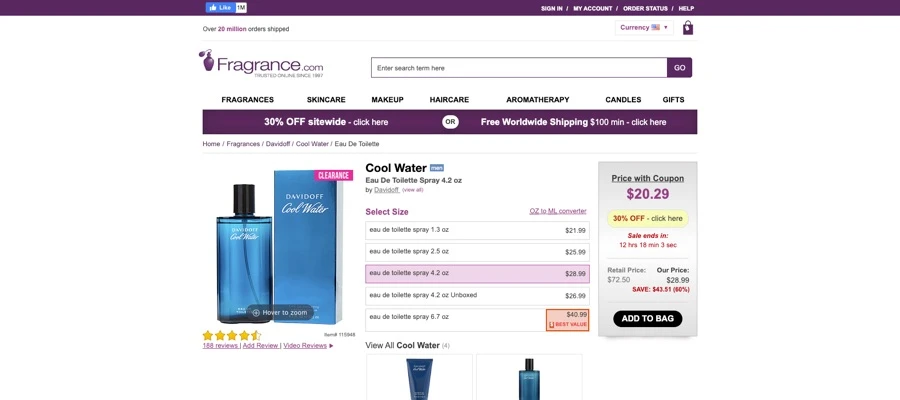
Our case study involves the checkout page on fragrance.com, where after selecting a five-star product, the customer’s choice is loaded onto a mini cart that displays other offers on bigger sizes of the item. Also, below the cart, we notice discounted products that are likely more expensive than the initial choice but offers more revenue to the owner of the website.
What Precautions Should You Take While Implementing Cross-selling and Up-selling Techniques?
1. Offer the Right Products
As we noted earlier, a simple way to shoot yourself in the leg with upselling and cross-selling is trying to offer a product that does not in any way match the primary purchase of the customer.
If you’re using a Recommended Item plugin or extension for your eCommerce store, then you must take care to match product categories manually, instead of relying on the automated selections made by the extension.
This way, you mitigate any risk of shoppers seeing an unrelated up-sell or cross-sell product while checking out.
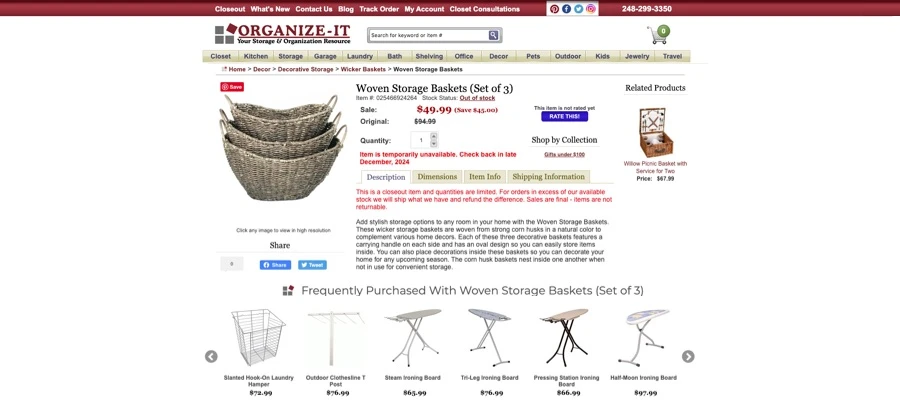
This example from Stacks and Stacks noted by CrazyEgg could be considered a demonstration of upselling gone wrong since the cost of some of the recommended products is way above the price of the primary purchase.
Additionally, there is no direct correlation between the recommended products and the initial item, while the cross-sell products are placed in a way that may not even catch the customer’s attention. Coupled with the clustered checkout page, this certainly is an example you don’t want to copy.
2. Avoid overusing phrases or sentences
To avoid giving a customer the impression that you’re only trying to get more money from their pocket, your cross-sell and upsell tactics must be concise and not too wordy that your customers see what you’re trying to do.
Like other eCommerce marketing tools, some Recommended Items extension allows you to set the phrase for upselling and cross-selling products. Once again, you can borrow a leaf from what other top sites in your niche and settle for what already works.
Additionally, you can decide to keep the recommended items section in only one or two pages in the sales funnel, namely the mini-cart and after an order is processed.
3. Be Proactive While Defining Copywriting
If you are creating a copy for the product you’re trying to up-sell, then it is essential that you abide by all the basic copywriting tips. Focus on the benefits that the customers stand to gain by purchasing the item and what they could lose if they fail to do so.
For instance, use emotion-triggering stories to tell the story of the current difficulty faced by the customer because they don’t have the item you’re upselling or cross-selling to them. Next, highlight the relief that could come with checking out with the item and lastly use a clear call to action (CTA) to close the deal.
As always, there is still something you can do better, which is to attach real-life testimonials or a video explainer for the product. All these features take the stress of deciding whether or not they buy from the customer and hopefully increases revenue for your eCommerce business.
4. Data Analytics Adds Up New Picture
Before you start up-selling and cross-selling products, you can review your online store’s sales history and key performance indicators (KPIs) to get more insight into which items customers order more and those they often order together.
Also, after implementing the strategies, a regular review of the pages on which you added them can reveal information about what you could improve to generate more results and of course, revenue for your business.
It is also from your data board that you can check on the result of A/B tests to see what works and what tweaks you can implement over time.
How to Leave the Door Open to Implement Further Cross-selling and Upselling Techniques
It is easy to believe that your job has ended after you convince a customer to spend more money than they initially wanted to on the primary product. However, smart business owners understand that this presents an opportunity to leave the door open for the next time you recommend a product to a customer.
Yes, you can take any of the following steps to achieve the desired result:
- Send a ‘Thank You’ letter to the customer shortly after sending their invoice.
- Send them a company swag or other promotional items at your disposal.
- Give them a free ticket to an industry event you are organizing or sponsoring.
- Offer them a discount code for future purchase on your website or any other affiliated business.
- Doing a spotlight on such high-ticket customers via your social media channels.
Remember that the objective is to maintain customer loyalty and encourage them to buy more; therefore, any cost spent on doing this can quickly be recovered from future sales.
Final Words
As we highlighted at the onset, up-selling and cross-selling products are marketing strategies that have worked effectively for eCommerce merchants within the last decades and brought in amazing results.
Back in 2006, Amazon CEO Jeff Bezos disclosed that they hit an incredible 35% of sales as a result of cross-sells, a figure that those done include all the additional revenue they generated from up-sells and bundling products.
More recently, Hubspot reported that the chances of selling to an existing customer stand at 60-70% while the likelihood of selling to a new customer is at 5-20%.
Putting these statistics into perspective, it is safe to say that you are only leaving money on the table as an eCommerce store owner if you’re not up-selling and cross-selling products on your website.
If you apply the marketing strategies that we’ve mentioned so far in the article, then you’re likely to get more results, increase revenue for your business and get on the path to giving customers more satisfaction when they shop with you.



